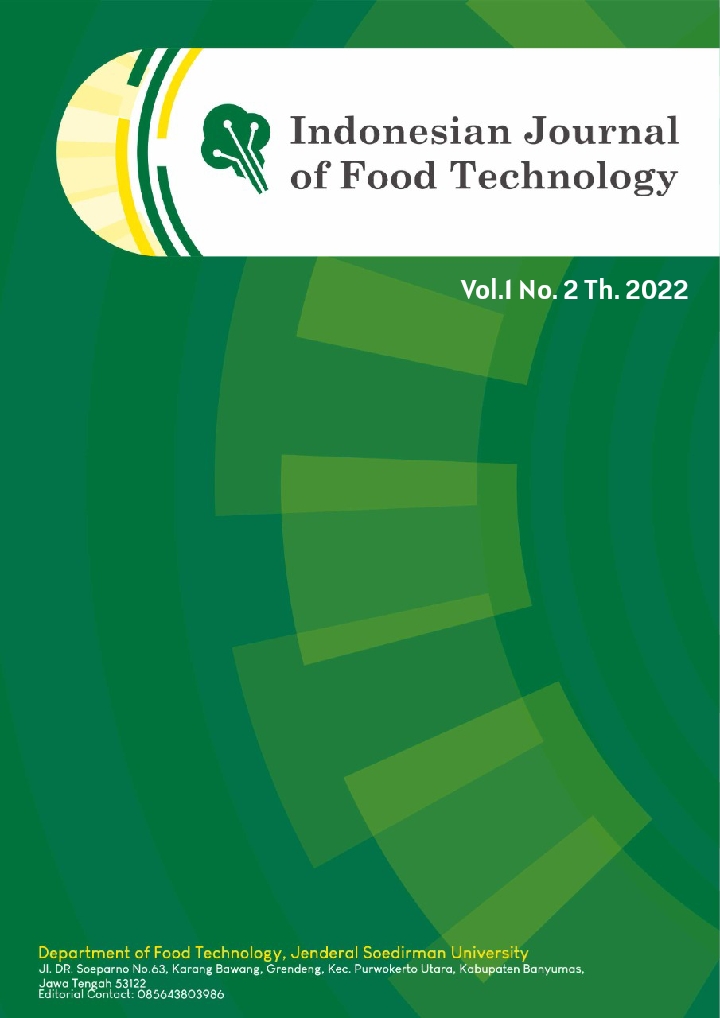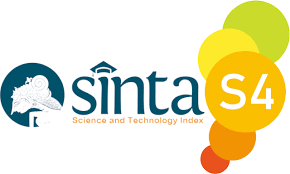Color of Karag Crackers with The Addition of Annatto Pigments and Variation of Types of Coatings
Abstract
Annatto pigment has the potential to be used as a natural dye. The addition of coating material is expected to act as a carrier and binder of annatto seed pigment in karak crackers. This study aims to determine the effect of the addition of annatto seed pigment and the type of coating on the color of coral crackers. Pigment coating is carried out using starch and maltodextrin. As a comparison, the pigment is directly added to the cracker dough, and as a control karag cracker is made without the addition of pigment. Coated annatto seed pigment was added as a colorant to the karag cracker dough with various concentrations of 2, 3, and 4%. Using the Munsen color dictionary, the potential of coated pigments as coloring agents was observed by measuring the hue, value, and chroma of the karag crackers. The results showed that the hue of karag crackers with the addition of annatto pigment produced a red color and mostly yellow-orange (YR) while the control (without the addition of pigment) produced a yellow color with a Hue (color) value between 2.5 to 5YR except for starch coating with a concentration of pigment 2% produces a red color. The use of maltodextrin coatings resulted in a lower value (brightness) (4.89) than starch (5.44) and without coatings (5.33), but chroma (color density) was not affected by the type of coating with chroma values ranging from 7.56 up to 8.44. Increasing the concentration of coated annatto pigment by 4% decreased the value of coral crackers, but the addition of both coated and uncoated annatto pigment concentrations was not able to increase chroma.
References
Anwar, E. (2010). Pemanfaatan maltodekstrin dari pati singkong sebagai bahan penyalut lapis tipis tablet. Makara of Science Series, 6(1), 50–54. https://doi.org/10.7454/mss.v6i1.36
Bitencourt, A. P. R., Duarte, J. L., Oliveira, A. E. M. F. M., Cruz, R. A. S., Carvalho, J. C. T., Gomes, A. T. A., Ferreira, I. M., Ribeiro-Costa, R. M., Silva-Júnior, J. O. C., &
Fernandes, C. P. (2018). Preparation of aqueous nanodispersions with annatto (Bixa orellana L.) extract using an organic solvent-free and low energy method. Food Chemistry, 257, 196–205. https://doi.org/10.1016/j.foodchem.2018.02.067
Chen, X., Ding, Y., Forrest, B., Oh, J., Boussert, S. M., & Hamann, M. T. (2019). Lemon yellow #15 a new highly stable, water soluble food colorant from the peel of Citrus limon. Food Chemistry, 270, 251–256. https://doi.org/10.1016/j.foodchem.2018.07.055
Gallardo-Cabrera, C. and Rojas-Barahona, A. (2015). Stability study of an aqueous formulation of the annatto dye. International Food Research Journal, 22(5), 2149–2154.
Handayani, I., Haryanti, P., & Sulistyo, S. B. (2021). Color and antibacterial activity of annatto extracts at various pH of distilled water solvent and extraction temperature. Food Research, 5(6), 247–253. https://doi.org/10.26656/fr.2017.5(6).740
Handayani, I., & Setyawati, R. (2020). Evaluation types of solvents on the extraction of Bixa orellana and application of extract on a chicken sausage product as natural colour and antioxidant sources. IOP Conference Series: Earth and Environmental Science, 443(1). https://doi.org/10.1088/1755-1315/443/1/012048
Handayani, Isti, & Sujiman. (2019). Aplikasi ekstrak kesumba (Bixa orellanna. L) sebagai sumber pewarna dan antioksidan alami pada getuk singkong. Jurnal Penelitian Pascapanen Pertanian, 6(3), 137–146.
Hirko, B., & Getu, A. (2022). Bixa orellana (Annatto Bixa): A Review on use, structure, extraction methods and analysis. Journal of Agronomy, Technology and Engineering Management, 5(1), 687–696.
Khasanah, L. U., Anandhito, B. K., Rachmawaty, T., Utami, R., & Manuhara, G. J. (2015). Skim terhadap karakteristik fisik dan kimia mikrokapsul oleoresin daun kayu manis (Cinnamomum burmannii). Agritech: Jurnal Fakultas Teknologi Pertanian UGM, 35(4), 414–421.
Martins, N., Roriz, C. L., Morales, P., Barros, L., & Ferreira, I. C. F. R. (2016). Food colorants: Challenges, opportunities and current desires of agro-industries to ensure consumer expectations and regulatory practices. Trends in Food Science and Technology, 52, 1–15. https://doi.org/10.1016/j.tifs.2016.03.009
Milotta, F. L. M., Furnari, G., Quattrocchi, C., Pasquale, S., Allegra, D., Gueli, A. M., Stanco, F., & Tanasi, D. (2020). Challenges in automatic Munsell color profiling for cultural heritage. Pattern Recognition Letters, 131, 135–141. https://doi.org/10.1016/j.patrec.2019.12.008
Nathan, V. K., Rani, M. E., Rathinasamy, G., & Narayanan Dhiraviam, K. (2019). Antioxidant and antimicrobial potential of natural colouring pigment derived from Bixa orellana L. seed aril. Proceedings of the National Academy of Sciences India Section B - Biological Sciences, 89(1), 137–143. https://doi.org/10.1007/s40011-017-0927-z
Prabhakara Rao, P., Narsing Rao, G., Jyothirmayi, T., Satyanarayana, A., Karuna, M. S. L., & Prasad, R. B. N. (2015). Characterisation of seed lipids from Bixa orellana and Trachyspermum copticum. JAOCS, Journal of the American Oil Chemists’ Society, 92(10), 1483–1490. https://doi.org/10.1007/s11746-015-2717-1
Priandana, K., S, A. Z., & Sukarman, S. (2016). Mobile Munsell Soil Color Chart berbasis android menggunakan histogram ruang citra HVC dengan klasifikasi KNN. Jurnal Ilmu Komputer Dan Agri-Informatika, 3(2), 93. https://doi.org/10.29244/jika.3.2.93-101
Pujilestari, T. (2016). Review: Sumber dan pemanfaatan zat warna alam untuk keperluan industri. Dinamika Kerajinan Dan Batik: Majalah Ilmiah, 32(2), 93. https://doi.org/10.22322/dkb.v32i2.1365
Raddatz-Mota, D., Pérez-Flores, L. J., Carrari, F., Mendoza-Espinoza, J. A., de León-Sánchez, F. D., Pinzón-López, L. L., Godoy-Hernández, G., & Rivera-Cabrera, F. (2017). Achiote (Bixa orellana L.): a natural source of pigment and vitamin E. Journal of Food Science and Technology, 54(6), 1729–1741. https://doi.org/10.1007/s13197-017-2579-7
Rivera-Madrid, R., Aguilar-Espinosa, M., Cárdenas-Conejo, Y., & Garza-Caligaris, L. E. (2016). carotenoid derivates in achiote (Bixa orellana) seeds: Synthesis and health promoting properties. Frontiers in Plant Science, 7(September), 1–7. https://doi.org/10.3389/fpls.2016.01406
Ruck, L., & Brown, C. T. (2015). Quantitative analysis of Munsell Color data from archeological ceramics. Journal of Archaeological Science: Reports, 3(October), 549–557. https://doi.org/10.1016/j.jasrep.2015.08.014
Shahid-ul-Islam, Rather, L. J., & Mohammad, F. (2016). Phytochemistry, biological activities and potential of annatto in natural colorant production for industrial applications - A review. Journal of Advanced Research, 7(3), 499–514. https://doi.org/10.1016/j.jare.2015.11.002
Vilar, D. D. A., Vilar, M. S. D. A., Moura, T. F. A. D. L. E., Raffin, F. N., Oliveira, M. R. De, Franco, C. F. D. O., De Athayde-Filho, P. F., Diniz, M. D. F. F. M., & Barbosa-Filho, J. M. (2014). Traditional Uses, chemical constituents, and biological activities of Bixa Orellana L.: A review. Scientific World Journal, 2014. https://doi.org/10.1155/2014/857292
Wahyuni, S., Rais, M., & Fadilah, R. (2018). Fortifikasi tepung kulit melinjo sebagai pewarna alami pada pembuatan kerupuk singkong. Jurnal Pendidikan Teknologi Pertanian, 3(2), 212. https://doi.org/10.26858/jptp.v3i2.5710
Widyani, R. (2021). Bumiku Indonesia: Bunga Rampai Kearifan Lokal. In Bumiku Indonesia: Bunga Rampai Kearifan Lokal. https://doi.org/10.14203/press.293
Wrolstad, R. E., & Smith, D. E. (2017). Color Analysis. In Food Analysis, Food Science Text Series (pp. 545–555). https://doi.org/10.1007/978-3-319-45776-5











